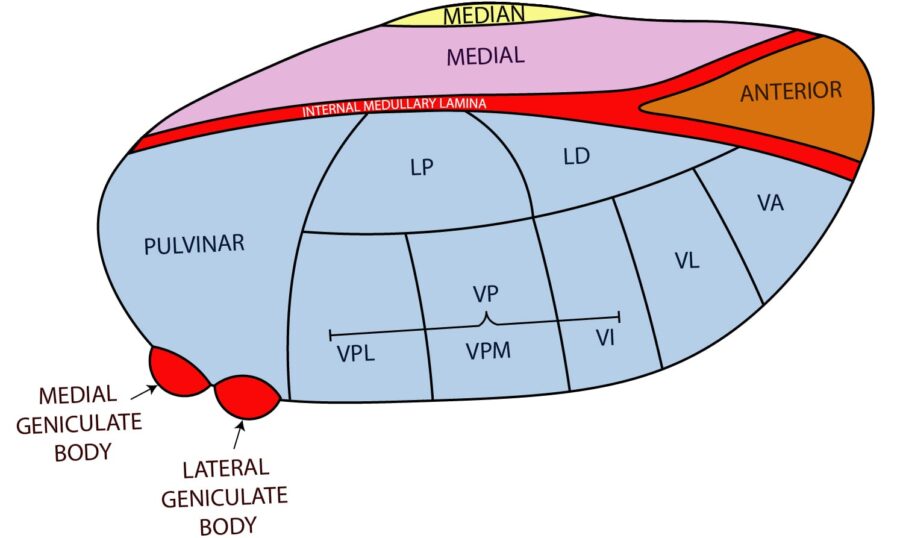The thalamus and hypothalamus are complicated subcortical structures. While they both originate from the diencephalon, these two structures have starkly different roles within the central nervous system. The thalamus is a subcortical grey matter structure that acts as a major relay center between the cortex and other subcortical areas while the hypothalamus has many nuclei with various roles; hormone synthesis, temperature regulation, hunger/thirst, etc. The hypothalamic-pituitary axis is an important topic for introductory neuroanatomy courses but is considered low yield for in-service and board examinations. Because of this, the intricacies of this topic will not be covered in-depth in this chapter. The goal of this chapter is to review the complicated roles of the thalamus and associated pathology and briefly review hypothalamic nuclei.
Author: James Eaton, MD
Editor: Brian Hanrahan, MD, Steven Gangloff MD
Thalamus
- The thalamus is a collection of subcortical grey matter and part of the diencephalon (along with the hypothalamus) involved in relaying information between different functional regions of the CNS.
- It borders the dorsal part of the third ventricle and functions as part of the lateral wall of the ventricle.
Thalamic nuclei
- There are three main types of thalamic nuclei: relay, association, and nonspecific nuclei.
- Relay nuclei have very distinct inputs and outputs.
- Association nuclei receive a majority of their input from the cortex and project fibers to other cortical regions.
- Nonspecific nuclei broadly project to numerous cortical regions.
Relay nuclei
- Ventral posterior lateral (VPL) nucleus: Relay center for sensory information of the body. The output is to the postcentral (sensory) gyrus.
- Ventral posterior medial (VPM) nucleus: Relay center for sensory information of the face. The output is to the postcentral (sensory) gyrus.
- The VPM is also the relay center for taste.
- Lateral geniculate body/nucleus (LGN): Relay center for vision. Receives input from the retina with output to the primary visual cortex via optic radiations.
- Optic radiations from the lower visual field (upper retinal quadrants) travel through the temporal lobe (Meyer’s loop) and optic radiations from the upper visual field (lower retinal quadrants) pass through the parietal lobe.
- Medial geniculate body/nucleus (MGN): Relay center for hearing. Receives input from the inferior colliculi and projects to the primary auditory cortex.
- Ventral anterior (VA) nucleus: Conveys motor information from basal ganglia to the premotor cortex. It plays a role in the initiation of movement.
- Ventral lateral (VL) nucleus: Conveys motor information from both the cerebellum and basal ganglia to the primary motor cortex.
Log in to View the Remaining 60-90% of Page Content!
New here? Get started!
(Or, click here to learn about our institution/group pricing)1 Month Plan
Full Access Subscription-
Access to full question bank
-
Access to all flashcards
-
Access to all chapters & site content
3 Month Plan
Full Access Subscription-
Access to full question bank
-
Access to all flashcards
-
Access to all chapters & site content
1 Year Plan
Full Access Subscription-
Access to full question bank
-
Access to all flashcards
-
Access to all chapters & site content


